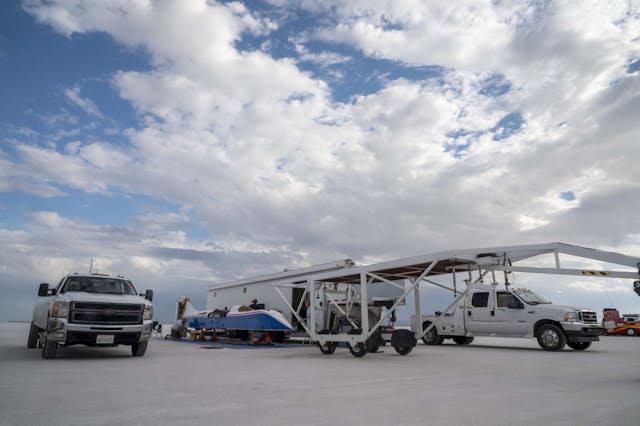Chasing 400 mph at Bonneville
Salt fever is an inexplicable affliction
Land speed racing is perhaps one of the oldest forms of motorsport on the planet, an evolution of the simple curiosity about the final battle between horsepower and aerodynamics. Where every other sanctioning body has attacked this natural fascination with pushing the machine to its ultimate limit, the organizations that have crystallized around the Bonneville Salt Flats have collectively protected this obsession for over a century. The pilgrimage to the Salt Flats comes in many forms, but for a weekend in mid-September, I joined Jim Knapp in his current pursuit of the 400 mph barrier with his Tom Hanna-built “Knapster 500,” a purpose-built race car that packs a mixture of drag racing and seemingly UFO technology into a 5200-pound missile that’s barely wider than the twin-turbo Brad Anderson Hemi tucked between the chassis rails.
The call for a last-second crew came out across the Utah Salt Flat Racing Association (USFRA) Facebook page, as Knapp was heading back to Bonneville after throwing the rods out at Speed Week 2021 and was short the hands needed to push the streamliner through a week of racing. With seemingly hundreds of Dzus tabs alone, never mind its hectic maintenance checks between rounds, running the Knapster 500 is something of a team effort by default in order to have a chance at good days on the salt, mechanically. It had been a few years since I squinted in the snowblind effect of Bonneville’s white wasteland, and the opportunity to wrench on something entirely different from the stock-bodied junk I had become accustomed to was impossible to waste. Bonneville is simply the case of engineering a specialty machine to the Nth degree of speed, with any distractions from steering, braking, and comfort set aside for a steamliner’s classic spaceship appearances, wheels tucked underneath the body and only a sliver of windshield poking above the deck for the pilot to scope the horizon.
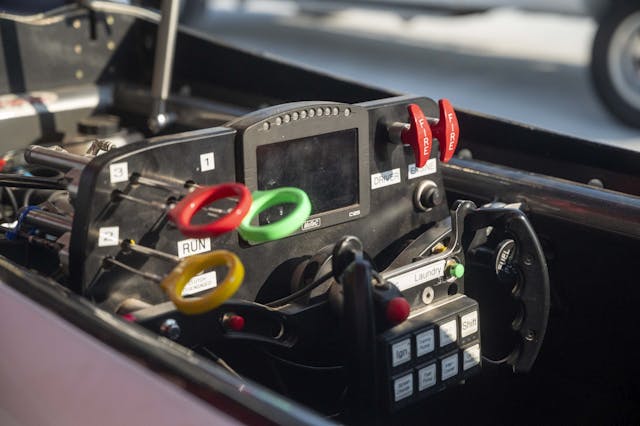
A Bonneville streamliner is a special case of engineering a machine to the Nth degree of speed. The result is a classic spaceship appearance, with wheels tucked underneath the body and only a sliver of windshield poking above the deck for the pilot to scope the horizon. In these tight confines of the typical streamliner is the ultimate challenge in packaging, getting everything sucked down into the smallest possible frontal area to ensure that every bit of traction and power available efficiently punches through the air. With that focus on compact dimensions, every streamliner on the salt ends up with its own unique recipe of engines, transmissions, steering systems, and problem-solving that serve as case studies in their own right for just how creative human beings can be when given no real restrictions to find the ultimate limitations of technology. For me, it wasn’t just about going on a little race-cation, but a chance to experience and learn from something out of this world compared to the machines of the past.
“Was this some airplane?”
The beauty of land speed racing is its open-door nature to spectators. We’re just a bunch of people racing, nothing is behind a velvet ropes, and questions about the streamliner’s origins were all over the place. Keen-eyed salt-heads will recognize this star-spangled streamliner as the Tom Hanna-built Maro Special of Bobby Moore, that used to be powered by a blown nitro Hemi, not unlike one you’d see between the frame rails of a Top Fueler, though with a front-mounted Pro Charger instead of the traditional blower. The front suspension was updated to a kingpin-style steering setup with actual knuckles at each corner of the nose instead of the old-school “wagon steering” that the Maro Special was built with, which is prone to torque steer when either front tire loses traction. The body, with its many windswept compound curves, was hand-formed out of Hanna’s shop from aluminum sheet. There isn’t an ounce of molded composites to be found here, and while tearing the bodywork on and off throughout World of Speed, it was hard to ignore just how perfect the metalwork was even on the back-side of the panels, without paint to hide any sins. Anyone who has had the pleasure of working around Dzus fasteners knows that getting repeatable assembly without having to arm wrestle them back into place is a sign of a true craftsman—or mad man—of race car fabrication.

Back to the mill that sits behind the driver, it’s a 499.6-cu-in Brad Anderson Hemi, not far removed from its cousins in the NHRA’s Top Alcohol class, though fed by a pair of 88mm Pro-Mod-spec Garrett turbos. The transmission behind it is an air-shifted B&J gearbox with five stacked planetary stages, similar to a Lenco, with an air clutch that keeps the motor free-spinning until the streamliner is up to speed while pushing off on the run. Power is then sent through a transfer case with the final drive ratio before it runs to the front and rear industrial angle drives that act as the ring and pinions for the front and rear wheels. Steering is limited, you can count the wheel angle on one hand, but given their nature for pencil rolling, streamliners aren’t known to need too much anyhow. Everything is meticulously controlled and logged by a Motec M800 ECU in combination with a C125 dashboard, something that we’d become very familiar with over the next couple of days.
“I’ve never had a clean run to Bonneville, never!”
I knew going into this that I’d be learning a lot about streamliners, but the skill set that was refined the most was simply trailer tire maintenance. It’s funny how a triple-axle enclosed unit gets just about as much disdain for maintenance as a rusty open-deck car hauler, but it seems to be the most common theme amongst racers. Even after swapping a tire by Lake Meade, one of the trailer’s drum brakes seized up and welcomed us with a 1076-degree reading on the thermal gun during a routine check. Still, we were making decent time through western Nevada’s post-card panorama of rolling hills and hidden oases, the kind of thing that define Wild West movies but you’ll never see from a glitzy hotel in Vegas.
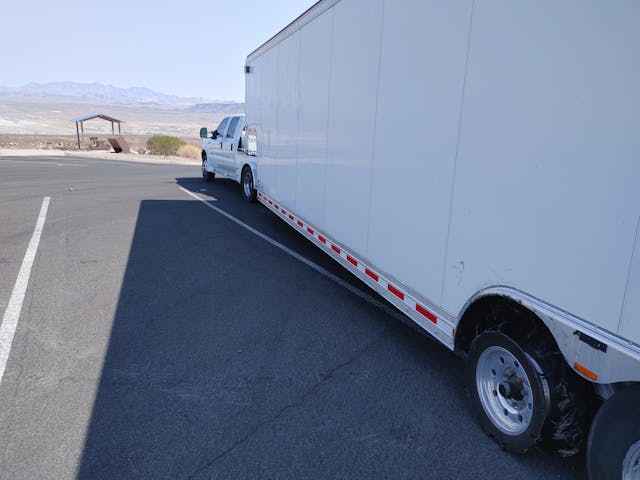
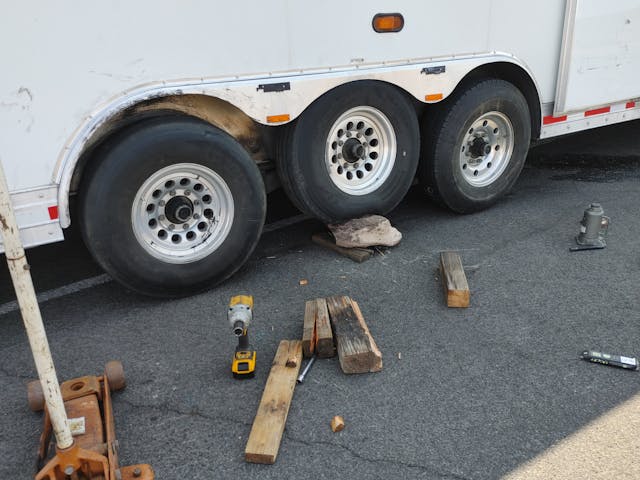
Winding into Wendover just past dark, Knapp and I had spent the time trading stories and catching up on life as fresh friends. I’d only known him for 12 hours by now, but like many old-timers in motorsport, there lay a hidden wisdom behind the facetious layer of jokes and tales. The next day, we crawled onto the Salt Flats in the same way you dip toes into a familiar body of water, the scene—its smells, its texture between the toes, the view that can’t be found elsewhere—is impossible to replace once you catch Salt Fever. From this point forward, it’s all good, even if the car caught fire on the trailer. We were soon joined by three other crew members, myself being the fourth of this impromptu cadre. Two were from the Team Vesco Turbinator II crew, Bob Hustler and Rick Kunze, and we were soon joined by a diesel tech whose work shirt only read by the name of “Bear,” with a handshake that backed the title.
Crewing at Bonneville is something like setting up Burning Man’s Black Rock City for gearheads, what feels like a small town floats on the Salt for a few days with a unique level of self sufficiency that somehow still encourages a selfless concern for everyone around you. The first thing once we chose the pit spot was to begin building a compound around the trailer, and this is truly where you can spot experienced salt heads from rookies. Packed inside like a champion Tetris player were tables, tool boxes, tarps, air compressor, generator, and enough extension cords to bow tie the globe. For our order of operations, the streamliner was rolled out on its gantry system before everything packed against the walls was methodically rolled out to build our little shop. With our work tables set up, flanked by toolboxes and tool chargers, it was time to focus on the streamliner itself, and the tubular contraption that shuttled it around when not making passes.
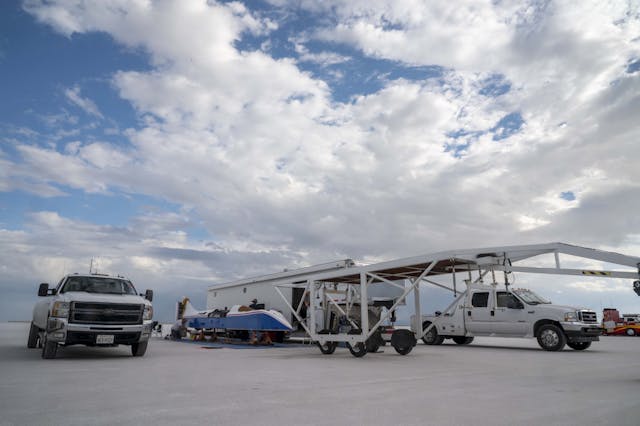
It might come as a surprise to some, but the low-down, tire-tucked nature of streamliners limits their maneuverability. They can high center on the curve of the globe if you’re not careful, and the city-block-wide turning radius that results from the limited steering angle afforded by the skirted front wheels prevents them from turning around at the return road easily. This gantry is essentially a trailer with a rigging system that lifts and locks the streamliner into its frame with a pair of winches, and while it could be easily managed by one person to lift and lower the streamliner, inevitably two of our team would automatically take either end of the hoisting operation. So, just to get this streamliner on the ground the first time, we rolled it out, pulled the turnbuckle struts that prevent the hanging streamliner from crashing into the sides of the gantry, and then clicked down the winches to gently lower it until all four tires finally touched the earth for the first time this week. Then, four big, thumb-sized pins were pulled from the body and locked into the hangers, before they were raised back up and the gantry was rolled away. Assembly is the reverse of disassembly, and while the game was like playing with a giant KNEX kit to start, it was a thoughtless routine by the time we had to make runs the following day.
400 mph or … bust!
Trepidation is the keyword of the day as we began prepping the streamliner for its first runs since Speed Week. Shakedowns are the final test of a lot of prep and theories, a reacquaintance with a machine before trusting that it’ll reach its limits predictably. I had fallen into the role of data acquisition—being a part of the internet generation, it’s practically automatic—while sharing duties with everyone else as we looked everything over for loose hardware, preheated the motor, and packed the parachutes. The initial goal was to just make a soft pass on the short course to give the streamliner a chance to crack its knuckles and collect some data before pushing above 300 mph again.

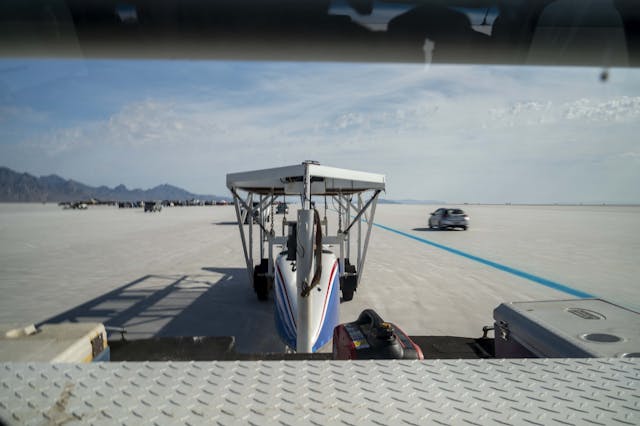
We split into two teams for each run, push truck and chase truck. The streamliner’s ability to cover ground at well over 300 mph along the four-mile course creates a logistics challenge in its own right. Even if we managed to pin the throttle on the push truck at 100 mph and chase it down into the shutdown area, we’d still take a good five minutes to get there; but towing the gantry needed to lift the streamliner back off the salt limited it to honest freeway speeds. Rick, being the radio fanatic of the bunch, had the best equipment to communicate to us at the start line and to Jim’s own comms in the streamliner over the miles of salt. He’d place himself near the end of the course and begin his chase as soon as we pushed off at the line. Leading up the start line is growing anticipation for the inevitable. A sea of vehicles and people begin parting as our turn comes up, revealing behind them the endless expanse of Bonneville with Floating Mountain on the horizon as the only landmark to shoot for. While Jim is strapped in, ice is rushed from the push truck into the intercooler at the last second, before all the hatches were battened.
“OK … let’s go!”
Given their incredibly tall gearing, many land speed vehicles need a push truck to get them up to a speed where the engine’s powerband can take over without lugging. Everything is optimized for the top-speed effort in land speed racing, and that is never more evident than with the streamliners’ unconventional drivetrains. On the nose of Jim’s F-450 was a platform flanked by two car antennas, with the streamliner using a small wheel on a post to make contact. Our job in the push truck was to smoothly, but quickly, get Jim up to around 60 mph before he coupled the clutch and began powering off in first gear. Riding it out for the first time is like pulling back on your first slingshot, the push truck whistling off as we load the streamliner for its shot across the salt, nudging the truck left and right while taking aim with Jim’s steering inputs.
Suddenly the RPMs of the Hemi click up, the clutch in the streamliner has engaged, and Jim slowly begins to outrun us as we ducked off to the return road. For the push truck, it’s a fairly leisurely cruise to intercept our chase truck and streamliner, but just a few miles ahead, Rick is already pounding salt as Jim comes up behind him with an extra 150 mph over his own cruising speed. Thankfully, nothing came across the radio of note as we eventually found Rick and Jim on the horizon. Drop gantry, pin the body, raise the streamliner, lock in the turnbuckle struts, and the car was up in the air before Jim had his fire suit off. Back at the pits, data logs showed that we had a fairly happy race car in our hands. The body panels were methodically stripped off to inspect the streamliner, one Dzus at a time like buttons on a shirt, to highlight the very reason why we ran a shakedown: oil was everywhere.
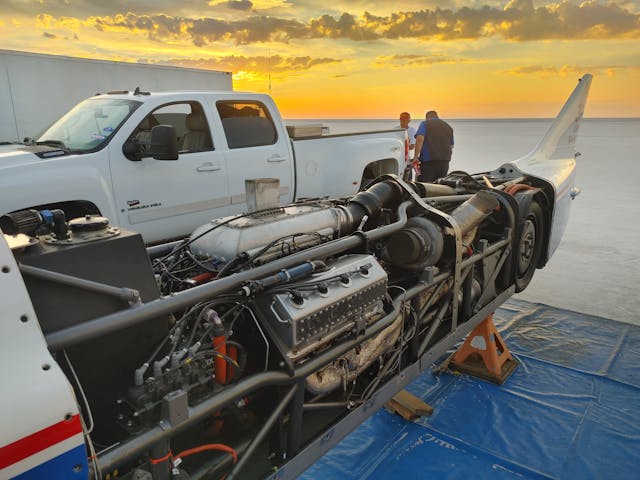
Salt-fueled ego death
Our crew was diverse in skillsets and experience, to put it softly. Rick’s background in radio communications and decades of experience at Kinsler Injection had given him the footing to later join Team Vesco’s wild, experimental turbine-driven efforts. Bob only admitted to working at Honda’s generator division, but clearly hid some NASCAR crewing experience up his sleeve. Bear, who we were pretty sure crawled out of the forests surrounding Baldy Mountain, Montana, before hopping in his Buick to meet us strangers, brought with him the humor under pressure only an experienced Marine could and coupled it with his methodical attention to detail from repairing modern tractors. Finally, there was me, a displaced Texan that had dabbled in wrenching on everything from Pikes Peak time attack cars to the odd nostalgia drag car.

Age varied across the spectrum with a good decade between most of us and having usually been the youngest in the room on any motorsport occasion, there’s sometimes an expected barrier between myself and the old-timers. At the Salt Flats, though, is the dissolution of these kinds of fences, or as Jay Meagher put it after his search for 300 mph, “They’re done being somebodies and they’re just being themselves.”
Problems in racing, a bad day or a small failure, test a crew’s bones more than anything. The great mystery before us was why, and where, the drivetrain was pushing oil into the belly pan. We had no easy solution. Jim knew the streamliner’s quirks best and had the most riding on his shoulders to see the streamliner through the week, but everyone knew what the machine needed to persevere and simply picked up the tools behind the next person, hopping over to one another as a backup when needed before quickly snapping back to their own little project at the moment. We had our suspicions after draining the transmission and engine oil, the tell-tales gave a general clue to the sources, but nothing was conclusive and everything was buttoned up and rechecked while running on the stands. In a rare form of coordination between strangers, brainstorming was just free-flowing ideas and considerations, without the competitiveness to be right that can strike a team down. The next day would be our shot at the long course, a solid sprint past 300 mph if nothing else failed, and we packed it in for the night with the streamliner hung and locked into the gantry, ready as it could ever be.


Four-mile Course
By the second run, we were a machine that could build a thousand well-oiled machines. A few students from Box Elder High School had found their way into our pits, and we handed off some duties to them to share the machine a little. For myself, having been in their position just a decade before, it was a strange passing of the baton, the title of the youngest, greenest passed down to see if they’ll even reach out and grab it.
The previous day’s racing had been shuttered by a wind storm that was blasting everyone in the way with salt, so while we had loaded in bright and early, it became the classic game of “hurry up and wait” while the racers who were lined up since yesterday finally got to make their runs. We had moved to the long course for the sake of a full-tilt pass. We would now have a four-mile course with the timed mile starting at the third. Reaching 400 mph wasn’t likely in this short of a course, it wasn’t the five-mile wonder of Speed Week, but seat time is seat time and the full-throttle shakedown added data and experience to that effort.
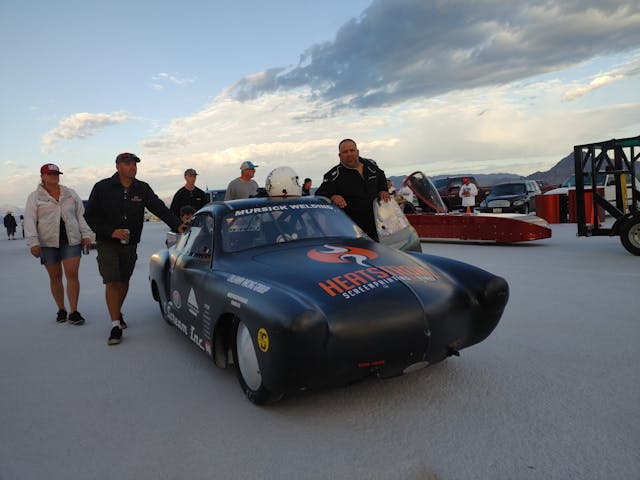

There’s no real count down, no green light at the Salt Flats. You find a place in line, like a kid at a cafeteria, and count heads until it’s your time to take a bite. Each step was marked by the cackle of some different motor, ripping off into the grey abyss before their progress was reported mile-by-mile across the radio. The early morning left the streamliner practically abandoned as we shot the shit, yet an ethereal countdown passively drew everyone back as the vehicles we referenced for our place in line went through their own rigamarole and headed for the horizon.
Send Ricco and Bear down track, pack Jim into the cockpit, slam ice cubes down a funnel into the intercooler, roll the push truck into contact.
At this point, there’s nothing in front of the team but our own run. As a crew member, the sight is just of a streamliner and a horizon, and to Jim, it’s even further isolated with nothing but the salt and floating mountain ahead of him as the USFRA starter walks him through the last hand signal checks like an aircraft carrier’s flight crew.
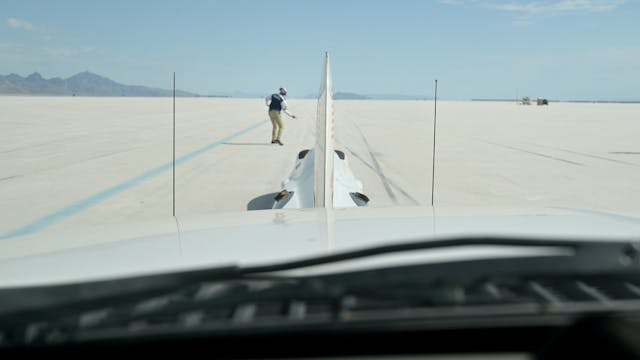
Roll into the throttle, try to not totally smoke out the crowd with coal, wait for the turbo-diesel’s boost to hit, and we were pushing off in a coordinated launch. With nearly three tons of machine ahead of us, the run to even 55 mph took a good 20 seconds, though, in the state of mild adrenalin and focus, the speed felt higher. Having crewed for a handful of racers, the send-off is always a little exciting, a little nerve-wracking.
CHHHHHZZZZT! “There was a fire, but it’s no problem; Jim’s safe”
The radio call from Rick was calm, like a pilot, the voice of experience and a well-measured reaction. We picked up the speed a little but kept it near highway pace with the gantry trailer jouncing along behind us. With a 314 mph exit speed, it took a few miles for Jim to slow, and we caught him near the 8-mile marker, motioning to pull close.
“Grab the cooler, the methanol tank is hot!”
We scattered water bottles, beer cans, and everything in the drink cooler for its ice-chilled water before hoisting it over the fuel tank to bring its temperature down. First glances had appeared that the fire was mild, but the risk of heated, potentially pressurized fuel was our immediate concern. Once things settled down, the streamliner was once again pinned to the gantry, lifted off the salt, and locked into place before we began the long cruise back to the pits. By now, the ideas were already spilling about what had happened.
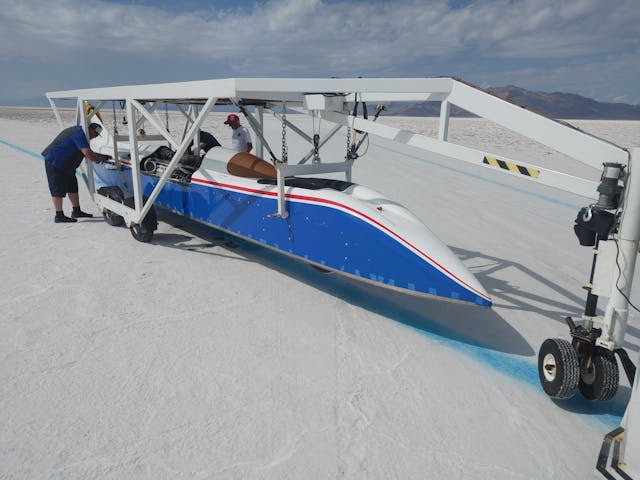
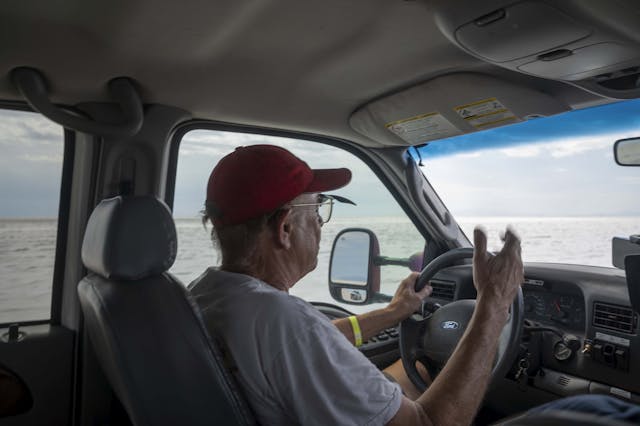
The trick of diagnosing failure in racing is that it’s rarely so obvious as it may appear. Chasing symptoms requires a universal understanding of how these machines operate in the minutia. It would be easy to blame the fluids we found the day before, but why were they there? What could’ve been the point of ignition on the front of the motor, the coolest region, and why did it only flash at the end of the run?
The data was pulled while we peeled back the wiring and plumbing, chasing burnt parts and soot around to spot the center of the fire. Damaged sensors could be seen in the logs too, confirming that the ignition point was after the run as pressure and temperature transducers went haywire. The exhaust gas sensors seemed to point at cylinder one going cold, but as much as we wanted to trust that number, it had to be held in contempt as its harness had also charred. Even while one or another were certain in their interpretation of the clues, the door was left open for any suggestion or disagreement.
Our main mystery is why crankcase absolute pressure began to rise, leaving a state of vacuum and going into positive pressure as fourth gear stretched on at over 7000 rpm. We focused on cylinder one, inspecting with a borescope and leak down tests, but nothing was hyper conclusive, or representative of the conditions of the run exactly either. A piston ring could have let combustion pressure through, even a leaking intake gasket could’ve pushed boost into the crankcase.
The exploratory field surgery went on until sunset before we packed in and retired to Carmen’s Black and White bar in Wendover. While it wasn’t what anyone had wanted, we all knew without saying how much worse things could’ve been, and a little melted copper is easier to work on than a whole new race car. And we didn’t have to replace the driver either.
With racing wisdom, there grows an acceptance for failure. No pursuit of speed is cleanly chased, no goal worth mentioning is without its setbacks and challenges. If it were easy, they say, everyone would do it, right? As you read this, the Knapster streamliner is back in Southern California for evaluation ahead of Jim’s last chance for the year at SCTA’s World Finals.
The Salt simply accepts anyone willing to try. Ambivalent to anything but passion and persistence, it awaits all.
